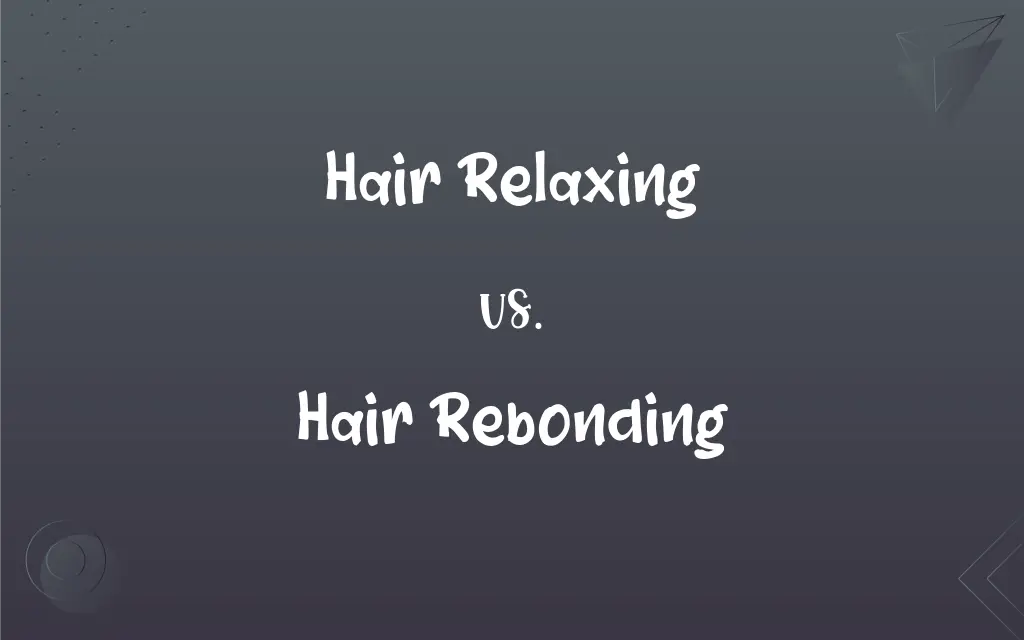Hair Relaxing vs. Hair Rebonding: What's the Difference?
Edited by Aimie Carlson || By Harlon Moss || Published on February 19, 2024
Hair relaxing is a chemical process to loosen curly or kinky hair, while hair rebonding is a process to straighten hair permanently by restructuring the bonds.

Key Differences
Hair relaxing involves applying a chemical relaxer to reduce the natural curl pattern, making the hair easier to straighten. Hair rebonding, in contrast, uses chemicals to break down natural bonds in the hair and then reforms them to create a straight, sleek look.
The aim of hair relaxing is to soften curls, making them looser and more manageable, not necessarily pin-straight. Hair rebonding is designed to deliver a permanently straight style, often resulting in a flat and smooth appearance.
Relaxers can be used on various hair types but are particularly popular for those with tight curls or African American hair textures. Hair rebonding is suitable for most hair types but is especially favored by those seeking to eliminate waves or curls entirely.
The process of hair relaxing is usually quicker and less intense than rebonding, offering a more subtle alteration of the hair's texture. Rebonding requires a longer, more detailed procedure, ensuring that each strand is meticulously straightened.
The effects of hair relaxing are semi-permanent and will need touch-ups as new hair grows in. The results of hair rebonding are permanent, although new growth will exhibit the hair's natural texture, requiring touch-ups.
ADVERTISEMENT
Comparison Chart
Primary Objective
To loosen curls
To straighten hair permanently
Result
Softer, looser curls
Pin-straight, sleek hair
Suitable Hair Types
Especially tight curls
All types, especially wavy/curly
Process Intensity
Less intense, quicker
More detailed, longer
Duration of Effects
Semi-permanent
Permanent, but needs touch-ups
ADVERTISEMENT
Hair Relaxing and Hair Rebonding Definitions
Hair Relaxing
Hair relaxing involves chemical treatment.
After hair relaxing, her coarse hair became easier to comb.
Hair Rebonding
Hair rebonding is suitable for most hair types.
Even with thick curls, hair rebonding gave her pin-straight hair.
Hair Relaxing
Hair relaxing offers a semi-permanent effect.
She gets hair relaxing treatments every few months for upkeep.
Hair Rebonding
Hair rebonding requires maintenance for new growth.
Post hair rebonding, she regularly touches up her new hair growth.
Hair Relaxing
Hair relaxing softens and loosens curls.
She got her hair relaxed to make her tight curls more manageable.
Hair Rebonding
Hair rebonding permanently straightens hair.
She chose hair rebonding for her naturally curly hair to achieve a sleek look.
Hair Relaxing
Hair relaxing is popular in African American hair care.
Hair relaxing is a common procedure in many African American salons.
Hair Rebonding
Hair rebonding restructures hair bonds.
Hair rebonding transformed her wavy hair into straight locks.
Hair Relaxing
Hair relaxing reduces hair's natural curl.
He opted for hair relaxing to tone down his kinky curls.
Hair Rebonding
Hair rebonding needs professional handling.
She went to a salon for her hair rebonding to ensure quality results.
FAQs
How long does hair relaxing last?
Several months, depending on hair growth.
Does hair relaxing make hair completely straight?
Not typically; it loosens curls rather than straightening.
Can relaxed hair be styled as usual?
Yes, but with caution to avoid damage.
What is hair relaxing?
A process to soften and loosen curly hair.
Is hair relaxing suitable for all hair types?
Primarily for tight curls or kinky hair.
What is hair rebonding?
A chemical treatment to permanently straighten hair.
Is hair rebonding damaging to hair?
It can be, due to the intense chemical process.
What care is needed after hair relaxing?
Use gentle, moisturizing hair products and avoid harsh treatments.
Can I color my hair after relaxing or rebonding?
Wait for a few weeks to avoid excessive chemical processing.
Are touch-ups necessary for rebonded hair?
Yes, for the new growth to match the rest of the hair.
How often should hair rebonding be done?
Only as needed for new growth, usually every 6-12 months.
Can relaxed hair be rebonded?
It's risky; usually, it's not recommended to overlap treatments.
What happens if hair relaxing is left on too long?
It can cause hair breakage and scalp irritation.
How to choose between relaxing and rebonding?
Consider your desired look and hair type; relaxing is less intense.
Can I swim with relaxed or rebonded hair?
Yes, but chlorine can cause dryness, so use protective measures.
Does hair rebonding affect hair growth?
No, it doesn't affect the growth rate but requires careful new growth treatment.
Is it safe to relax or rebond hair during pregnancy?
Consult a doctor first, as chemicals may pose risks.
Can I do hair rebonding at home?
It's not recommended; professional service is safer.
How to maintain rebonded hair?
Use sulfate-free shampoos and avoid excessive heat styling.
Does hair rebonding work on very curly hair?
Yes, it's effective on most hair types, including curly.
About Author
Written by
Harlon MossHarlon is a seasoned quality moderator and accomplished content writer for Difference Wiki. An alumnus of the prestigious University of California, he earned his degree in Computer Science. Leveraging his academic background, Harlon brings a meticulous and informed perspective to his work, ensuring content accuracy and excellence.
Edited by
Aimie CarlsonAimie Carlson, holding a master's degree in English literature, is a fervent English language enthusiast. She lends her writing talents to Difference Wiki, a prominent website that specializes in comparisons, offering readers insightful analyses that both captivate and inform.







































































